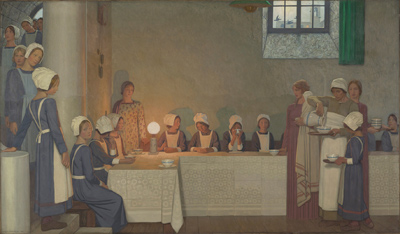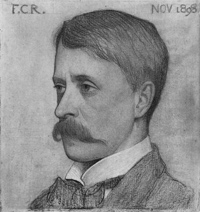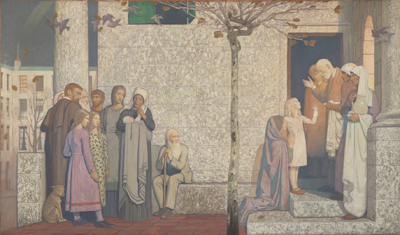Acts of Mercy , four striking allegorical panels by a largely forgotten but highly talented early 20th-century artist, have been saved from London’s demolished Middlesex Hospital. They can now be seen in London’s National Gallery until 17 October.
 |
ACTS OF MERCY, four striking allegorical panels by a largely forgotten but highly talented early 20th-century artist, have been saved from London’s demolished Middlesex Hospital. They can now be seen in London’s National Gallery until 17 October.
Commissioned by the hospital’s Governor and benefactor Australian-born tycoon (Sir) Edmund Davis in 1912, the four large oil panels are by Frederick Cayley Robinson, a British Symbolist. They hung in the entrance hall of the former 18th-century Middlesex Hospital in Fitzrovia – rebuilt between 1928-35.
They were admired by decades of patients and visiting art lovers and, when the building was threatened with demolition in 2008, it was feared that the four panels were too large to fit easily into another gallery and would be lost or separated. Bought at the last minute by the medical archive and museum, the Wellcome Trust, they normally hang in its Library, but are currently on view in the National Gallery’s Sunley Room.
 |
Cayley Robinson (1862-1927) studied Renaissance painting and became an expert in the use of tempera. He was an admirer of Giotto, Mantegna, Michaelangelo, Puvis de Chavannes, della Francesca and Botticelli – whose works can be seen in other rooms in the National Gallery – and, at first sight, his works appear impassive, but in fact contain a striking variety of mood and atmosphere.
Although there are four panels, each is twinned. Orphans shows young women in drab grey or brown dresses and white caps eating or carrying trays of food to a long table. A nurse pours milk into a little girl’s bowl while a ginger cat at her feet watches what’s going on. The windows are high and the only light comes from a small table lamp. Some of the girls are chatting but none is laughing or even smiling. It shows the queuing and regimentation of institutional life, but also celebrates the hospital’s work in helping orphans. The only free spirits are the swallows behind the glass.
The second two works entitled The Doctor have stylised backgrounds of the Middlesex Hospital itself and Fitzrovia‘s Georgian houses. In one panel, wounded soldiers in their traditional blue hospital uniforms and a thin civilian in a top hat gather around the steps smoking and talking. They are presumably waiting for the doctor.
In the last panel, the medical man himself – who looks like Cayley Robinson – is behaving in an almost god-like way towards a young child, while other patients look on and a woman kneels to thank him for saving her daughter. There are symbolic references to Hygieia, daughter of Aesculapius, the tree in which the snake dwelt in the Garden of Eden and doves of peace.
These are not happy pictures but they are beautifully painted and so striking that it’s difficult to get their images out of your head for quite a while.
Acts of Mercy is at the National Gallery, Trafalgar Square, London WC2 until 17 October; admission free. Tel: (020) 7306 0055
 |
Images: Frederick Cayley Robinson (1862–1927) (top) Acts of Mercy: Orphans II, about 1915; (bottom) Acts of Mercy: The Doctor II, 1916.
The Wellcome Library, London. Image © The Trustees of the Wellcome Trust Ltd. (Centre) Frederick Cayley Robinson (1862–1927). Self-portrait, 1898 © National Portrait Gallery, London






 © 2024
© 2024